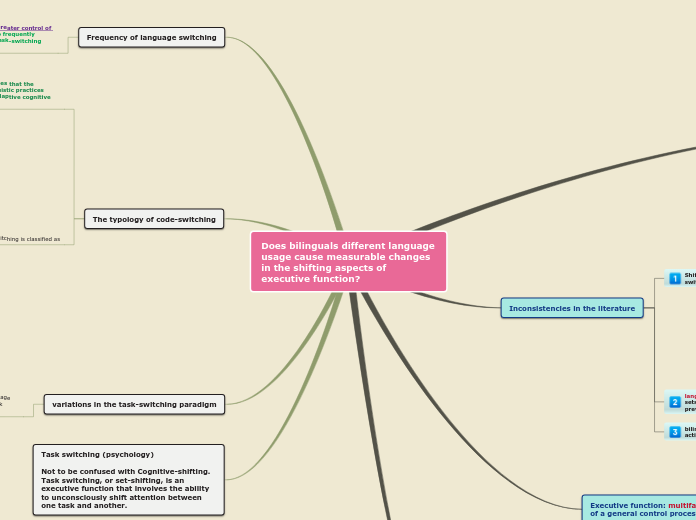av karen maria angelica peña cardenas för 5 årar sedan
462
Does bilinguals different language usage cause measurable changes in the shifting aspects of executive function?
This is a sample mind map

av karen maria angelica peña cardenas för 5 årar sedan
462

Mer av detta
in contrast studies that tested either young children or adults have reported relatively consistent bilingual advantages.
therefore it is not surprinsing that the majority of studies that tested young adults (who have likely reached the peak of their cognitive functioning) have reported either null or inconsistent findings-
it is more demanding than intrasential as it requires language set reconfiguration and proactive inhibition.
it is believed that this type of code switching is further influenced by who initiates the discourse.
other-initiated is triggered unexpectedly and therefore imposes greater demands on language-set reconfiguration and proactive inhibition-
morefrequent exercise of other-initiated intersentential code switching is likeli to be more beneficial for switch costs than self initiated intersentential code switching
self initiated intersentential code switching seems to be less costly and relatively less taxing than other initiated intersentential code switchings because it allows sufficient preparation time to reconfigure language sets.
eg: interchanging two or more languages between sentences
does not necessarily entails a substantial shit from one linguistic set to another.
facilitates language production by permitting the speaker to use whatever comes most readily.
characterized by loan words that are integrated into the other languages syntactic context (eg: grammar)
eg: mixing linguistics units from two languages within a sentence
refer to slower responses on task-repeat trials in mixed-task blocks than in pure blocks.
Pure blocks: consist of a single task
reflect the cost of monitoring and coordinating multiple streams of incoming information.
they entail the activation of global control mechanisms that are necessary to monitor task cues, maintain two competing tasks/response sets, and make task-appropriate decisions.
SC are driven by local control mechanisms that involve
inhibition of proactive interference
ability to regulate interference from the previously formed task-set
task-set reconfiguration
It is the ability to change from one task to another
So, they reflect the actual cost of switching between different task sets.
Eg: color shape or number letter tasks
Specifically bilinguals dual language context engages a more complex and taxing level of control pprocesses of goal maintenance, conflict monitoring and interference suppression.
there are 3 different interactional contexts
codeswitching context
Bilinguals routinely mix the linguistic elements of two languages within a single utterance
single language context
bilinguals speak only 1 language in one environment and therefore rarely switch languages
English at home and Spanish at work
the duallanguage context
given that bilinguals in a dual-language context should experiencenot only more frequentbut also more qualitative challenging language switching it is conceivable that the dual-language context will promote shifting EF and therefore enhance task switching performance.
bilingualswho mainly engage in a duallanguage context show smaller switch costs than those who mainly engage in a single language context
engages a more complex and taxing level of control processes of goal maintenance, conflict monitoring and interference suppression. Therefore facilitates more adaptivecognitive control than either the single language or dense code switching context.
bilinguals use 2 languages L1 and L2, within the same context
Eg: at home and at work (both English and Spanish)